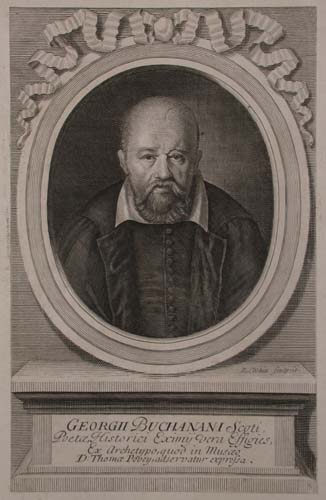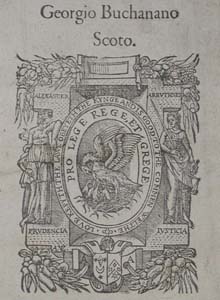| Please note that these pages are from our old (pre-2010) website; the presentation of these pages may now appear outdated and may not always comply with current accessibility guidelines. |
| Please note that these pages are from our old (pre-2010) website; the presentation of these pages may now appear outdated and may not always comply with current accessibility guidelines. |
George Buchanan 1506-1582An Introduction to Buchanan
|
Buchanan Home Page |
Virtual exhibition of Buchanan's books |
 Portrait of Buchanan, after preface. Opera Omnia (Sp Coll Bo 1.7) |
This text was written for the quatercentenary of Buchanan's death in 1982 and has been left largely unedited. George Buchanan is mainly celebrated to-day for his radical political ideas, but contemporaries knew him also as an internationally famous poet and scholarly tutor to kings and queens, while the best of European printers disputed the honour of printing his works. His autobiography, the Vita whose earliest printing can now be dated to 1595, affords a merely skeleton account of his restless career and leaves many questions unanswered. Recently we have had fuller information on his early travels abroad, notably the formative years in France, the imprint of which on him can scarcely be undervalued. His first book was a modest translation of an English grammar by Thomas
Linacre, tutor of More and correspondent of Erasmus. With it he included a work
by the Spanish educator, J.L. Vives, a student of whose was Buchanan's
contemporary at Paris: a school text that for thirty years almost cornered the
French market, but that somehow never caught on at home. Replacing it there was
the Duisburg version of Despauterius, to whose grammar was sometimes annexed,
but posthumously Buchanan's De prosodia libellus, Buchanan carrying more
authority on verse-making than Despauterius. This first appeared as a slight
pamphlet in 1595. In spite of his production of teaching aids, Ronsard tells us
that there was nothing teacherly about Buchanan except his gown, and indeed he
confided to Andrew Melville that teaching was only preferable to sheep-stealing,
while his verses portray the schoolmaster's day as a deadening routine
punctuated by spasms of flogging. Yet he had a powerful didactic drive and it is
to his gift that Glasgow University owes its earliest surviving library of
humanistic texts. |
|---|
| Greek scholarship was still unusual, when, following the model of Erasmus, he make Latin renderings for the Bordeaux undergraduate theatre of the tragedies of Euripides, with the Medea available to a wider public by 1544 and the Alcestis not till 1557. At one point Buchanan aimed some unfavourable lines at More, yet, on his own testimony, his first play, the Baptistes, used the Baptist to personify More's resistance to Henry VIII, though decades were to pass before, as a committed Protestant, he offered it for publication in a totally different religious context and in response to the promptings of the Englishman, Daniel Rogers, on behalf of the circle surrounding Sir Philip Sidney and the Earl of Leicester. With more impact on the French Renaissance state and arousing the interest even of Italian translators, his Jephthes sought to marry a biblical theme to classical analogues in Agamemnon and Iphigenia. Student actors and playwrights shared a common delight; Montaigne remembered the plays fondly and the Jephthes inspired a young Portuguese dramatist, Antonio Ferreira, to write his very similar Castro. |
|
|
Master of many styles, Buchanan's strongest vein in poetry was envenomed satire and his Franciscanus, a biting critique of the friars setting out to paint them as the opposite of all they claimed to be, got him into ecclesiastical hot water before its postponed appearance in the liberal air of post-Erasmian Basle; in another Reformed centre, Geneva the censors were less accommodating and tended to cut lines seeming to overstep the bounds of the permissible. Translating the Greek anthology formed a sound base for learning how best to pack a verbal punch and extend his poetic range, and in 1553 Buchanan associated with others in compiling a students crib to partner the Greek original issued by Adrien Turnèbe. In the next decade in newly Protestant Scotland a few barbed anti-papal and anti-monastic epigrams appeared at Lekprevick's press. A less meagre allowance was afforded by the 1567 Estienne edition and that in Basle the following year, where Buchanan had the company of his friends in the Pléiade, the great school of French Renaissance poets, influencing each other to their mutual benefit. The first really substantial offering had, however, to await the 1584 edition of the poems sponsored by Daniel Rogers. Where before he was pro-Guise, his Protestantism forced him to be anti-Guise and he appeared among other anti-League poets in the 1590 anthology published anonymously by Jacob Stoer as 'Israel Taurinus'; here also appeared his elegy on John Calvin. Nothing in the way of a collected edition was printed in Edinburgh till 1615, for Buchanan's light verse was too light, probably too erotic, for his Scots friends who collectively, as he puts it, 'plotted' to persuade him to turn to weightier and prosier matters. |
|---|
|
|
The Sphaera was versified science; the didactic side again of Buchanan, but
with something of a religious awe before the vast spaces of creation. This again
is found in the paraphrases of the Psalms, a work for long in the best-seller
category.
The Paraphrases were mostly composed in a Lisbon monastic setting and under the eye of the Inquisition, but their pastoral background and non-controversial religion suited Buchanan's mood and were part of a contemporary attempt to find for prayer a new Renaissance language. Andrew Melville, a more proficient Hebraist, was introduced to them by the poet himself, and duly made his own versions which were never printed. Henri Estienne first published his selection in an international company of paraphrasers. He especially singled out Psalm 104 and the great Antwerp printer, Plantin quickly followed suit, choosing it to set off the 'divine' poems of Marcantonio Flaminio But above all it was the German editions with music and pedagogical aids that captured the market, prefaced, as Buchanan might not have desired, by his limpid, courtly lines in praise of Queen Mary. The metrical variety of Buchanan's renderings charmed contemporaries, a variety imitated even in Polish by Jan Kochanowski. |
| Illustration of the Earth inside front cover (Mu50-e.33) | |
|---|---|
page122small.jpg) Illustration of the Sun orbiting the Earth, Page122 (Bl7-h.23) |
 |
More familiar nowadays are his anti-Marian vernacular political polemics. His
plays had apprenticed him to dialogue which he used with devastating effect to
subject kings to radical scrutiny in his 'mirror for princes,' the De jure regni.
That, however, with the bulky Historia, was frowned on by King James and Queen
Elizabeth.
Modelled on the Scots history of the credulous Hector Boece more than on the soberer John Mair or Major, it was severe mostly on England's legendary origins. Pointing a moral offered more satisfaction than intrinsic human interest, though the opening pages reflect his deep classical reading as well as his fascination with Celtic topography, and the final pages constitute his apologia for the Regent Moray. The history was long in the making; first heard of in 1555, a text of 1577 was once in this library, acquired by Thomas Jack, then bursar-librarian. Since then Glasgow has built up a notable Buchanan collection to which David Murray, his bibliographer, has made solid contributions. |
| Printers device, title-page (Hepburn q7) |
|---|
The crowning edition by Thomas Ruddiman is still a landmark. But the final edition of the poems that so won the admiration of the French Renaissance masters, some of them only recently unearthed in manuscript, still lies ahead. JOHN DURKAN |
Buchanan Home Page |
Virtual exhibition of Buchanan's books |